Limiting carbs is one of the easiest ways to get into ketosis. It doesn’t require fasting; it doesn’t even require you to eat fewer calories — all you have to do is restrict your carbohydrates and eat just enough protein (and not too much) to stimulate fat burning and ketone production.
Other factors like fat consumption, stress, and activity levels are important to consider as well, but knowing how many carbs you need to eat to get into ketosis is a good place to start.
How Many Carbs For Ketosis?
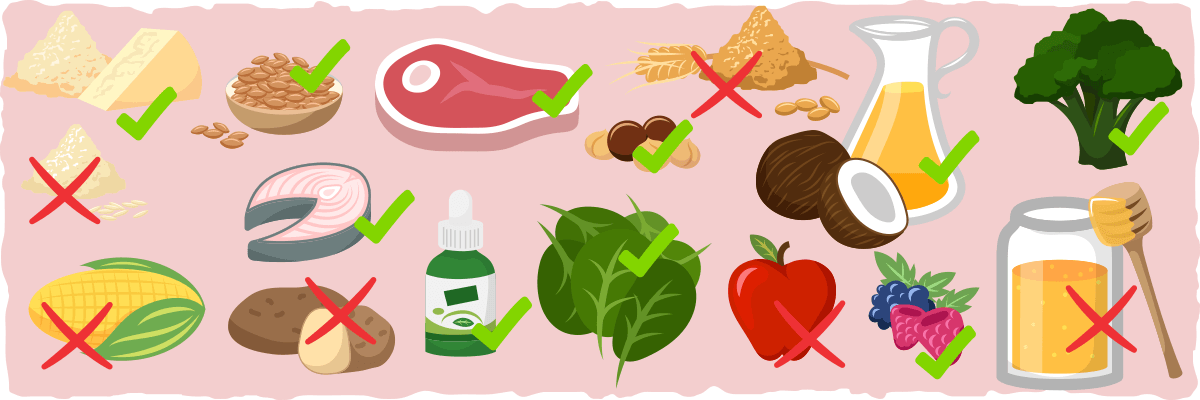
Regardless of how many variables impact ketosis, it is important to start somewhere, and carbs are the most important metric to start with on the ketogenic diet.
For most people, keeping total carbs below 35g and net carbs below 25g (ideally, below 20g) will get them into a deep ketosis after about a week. (To figure out your net carb consumption, simply subtract total fiber intake from total carbs.)
Note: Some sweeteners are considered keto-friendly and do not raise blood sugar levels. These can be subtracted from the total carbs as well. For more, read our Guide to Low Carb Sweeteners >
To eat such a small amount of carbs, you must be vigilant about your food choices. You may find that many of your favorite foods will put you over the carbohydrate limit for the day with just one serving. Even healthier foods like fruits and vegetables are packed with sugar and carbs, but don’t get discouraged — there is plenty of delicious food you can eat on the ketogenic diet.
For example, you can have a Bacon Breakfast Bagel for breakfast, a Thai BBQ Pork Salad for lunch, and a Keto BBQ Chicken Pizza for dinner. Mouthwatering aren’t they?
Check out this list for some more ideas of what you should and should not eat on the ketogenic diet:
Do Not Eat
- Grains – wheat, corn, rice, cereal, etc.
- Sugar – honey, agave, maple syrup, etc.
- Fruit – apples, bananas, oranges, etc.
- Tubers – potato, yams, etc.
Do Eat
- Meats – fish, beef, lamb, poultry, eggs, etc.
- Leafy Greens – spinach, kale, etc.
- Above ground vegetables – broccoli, cauliflower, etc.
- High Fat Dairy – hard cheeses, high fat cream, butter, etc.
- Nuts and seeds – macadamias, walnuts, sunflower seeds, etc.
- Avocado and berries – raspberries, blackberries, and other low glycemic impact berries
- Sweeteners – stevia, erythritol, monk fruit, and other low-carb sweeteners >
- Other fats – coconut oil, high-fat salad dressing, saturated fats, etc.
To see more specific advice on what (and what not) to eat, click here >
But even by following this list, you can easily eat over 35 grams of total carbohydrates for the day. This is why it is essential to track your carbs with an app like MyFitnessPal. (Read our article on the easiest way to track carbs to find out how.)
You must not forget, however, that getting into ketosis isn’t all about the carbs you eat. Protein plays an important part on your path toward ketosis as well.
The Importance Eating The Right Amount of Protein for Ketosis
When you restrict carbohydrates, you are starving your body of its primary fuel source. At first, it will burn off its stored glycogen (stored sugar).
However, after the glycogen is depleted, the body doesn’t go right into ketosis — it starts using gluconeogenesis. Gluconeogenesis is a metabolic pathway that turns non-sugar sources into sugar. Among these non-sugar sources are a handful of amino acids that are found in protein. These amino acids become our primary energy source for a couple of days to weeks, depending on how much protein we eat.
When protein intake is too high, the body is flooded with enough amino acids to feed the process of gluconeogenesis and provide enough energy for the body.
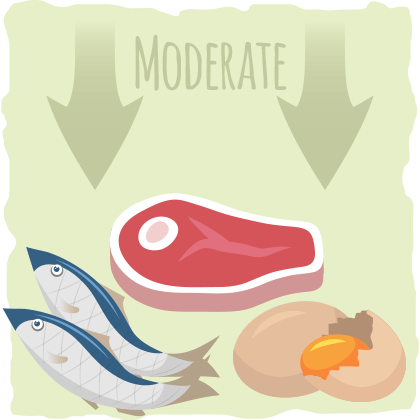
Insulin (an energy storage hormone) is also released when we consume protein. Part of its role is telling the cells that plenty of energy is available, so we don’t have to burn fat from fat cells and produce ketones.
After each high-protein meal, insulin and amino acid energy sources increase, which prevents the body from reaching deeper levels of ketosis.
This is why only eating 35g of carbs or less is not the only thing you should focus on when getting into ketosis. It is vital for you to eat the right amount of protein as well.
In general, you should aim to get around 25% of your calories from protein. If you’re active or restricting calories for fat loss, then it is best to increase your protein intake. To find out the exact amount of protein you should eat, use our keto calculator.
Once you eat the right amount carbs and protein daily, you should be in ketosis in a couple of days to a week. However, some things may happen on the path to ketosis that you must know about.
How to Prepare for Ketosis
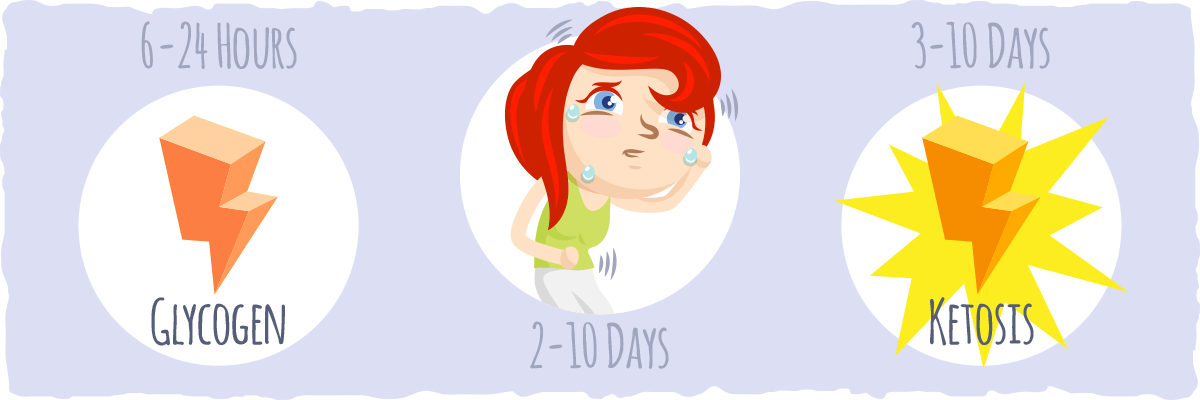
Due to many different genetic and lifestyle factors, every individual will have a unique journey to ketosis. Some may get into a deep ketosis in 3 days, while others may not be in ketosis until a week after starting the ketogenic diet. Some may have no side effects, while others will get flu-like symptoms called the keto flu.
So, as with any journey, let’s prepare for the worst so that you can feel your best no matter what happens. First, you must understand what your body is going through, and then we will figure out what to do about it.
What Happens to Your Body Before Entering Ketosis
For your body to adapt to carbohydrate restriction, it must make many changes from the cellular level to the hormonal level. To get a better understanding of what happens, let’s break the path to ketosis into phases.
Phase 1 — The Glycogen Depletion Phase — 6 to 24 hours after starting the ketogenic diet
During this phase, most energy is provided by glycogen. Due to the lack of dietary carbohydrates, insulin levels start dropping, causing more water and sodium to lost in the urine than usual. Some people may experience mild dehydration symptoms like dizziness and fatigue.
Phase 2 — The Gluconeogenic Phase — ~2 to 10 days on the ketogenic diet
During this phase, glycogen is depleted, and gluconeogenesis takes over to provide the body with energy. At this point, so much water and sodium are lost that many people experience flu-like symptoms if they don’t replenish their fluids and minerals. The window of time for this phase is so broad (two to ten days) because it depends on many genetic and lifestyle factors.
Phase 3 — The Ketosis Phase — ~3 to 10 days on the ketogenic diet
This phase is the phase you want to be in on the ketogenic diet. It is characterized by a decrease in protein breakdown for energy and an increase in fat and ketone use. During this phase, ketones can supply up to 50% of your basal energy requirements and 70% of your brain’s energy needs. Depending on many genetic and lifestyle factors, it may take you anywhere from 3 to 10 days to get to this phase.
There you have it — the stages that everyone goes through before reaching ketosis. If this is too sciencey for you, think of this process as being synonymous with the adjustment period we go through after ending a relationship with someone we love very much. It takes time to move on to dating other energy sources and just like after ending a long-term relationship, breaking up with carbohydrates can cause a laundry list of symptoms called the keto flu.
How to Prepare For the Worst-Case Scenario
The keto flu is the body’s response to the rapid changes that occur on the path to ketosis. You can remedy the keto flu and possibly even prevent it by following these simple suggestions:
- Drink plenty of water (at least 2.7 liters for women and 3.7 liters for men)
- Consume at least a teaspoon of unprocessed salt per day
- Supplement with magnesium and potassium
- Do some low-intensity aerobic exercise in the morning to encourage fat burning
- Reduce stress by meditating and improving sleep quality
- Eat more fat
For more details on what to do, read our article on the keto flu and how to remedy it.
Now that we know how to get to ketosis without any metaphorical bumps and bruises, let’s find out how to get into ketosis faster.
How To Get Into Ketosis Faster
You are eating the right amount of carbs and protein to get into ketosis, you remedied the keto flu, and yet you still aren’t in a deep ketosis. What should you do?
Well, there are two methods we can use to get into ketosis more quickly. The first is sprinting the path of ketosis, and the second is skipping it all together.
Sprinting to Ketosis
With a combination of fasting and exercise (or using one or the other), we can rush through the phases on the path to ketosis that we don’t want to be in — the glycogen depletion phase and the gluconeogenic phase.
To shorten the glycogen depletion phase, we can:
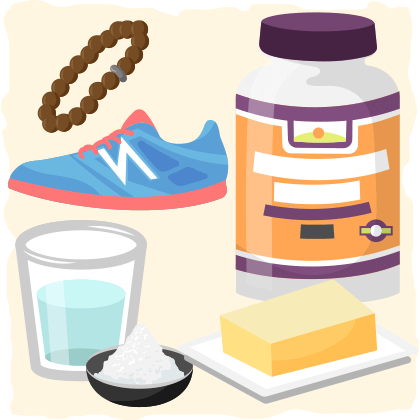
- Do one high-intensity training session for an hour or more
- Fast from all calories for 20-24 hours
High-intensity training is the one form of exercise that relies solely on carbohydrates. Studies show that just an hour of high-intensity interval training can almost completely deplete glycogen levels.
If you combine high-intensity training with fasting, then you’ll get to the gluconeogenic phase as fast as possible.
To shorten the gluconeogenic phase, we can:
- Do low-intensity aerobic exercise like walking every morning
- Fast from all calories or only eat fat for 2-3 days
Low-intensity aerobic exercise walking will encourage your cells to burn fat for fuel while fasting keeps dietary protein from providing the cells with an extra energy source.
Implementing these suggestions into one plan will look something like this:
Day 1
- Start the morning with 60 min high-intensity training
- Fast until dinner or fast for 1-2 more days
Day 2
- Start the morning with 60 min of low-intensity activity
- Fast for a day or two
- Supplement with fat (like MCT oil), if you need some extra energy
- Check your ketone levels throughout your fast
Day 3 or 4
- Break the fast with a high fat, moderate protein meal if you are in deep ketosis (there will be more on what “deep ketosis” means later in the article)
- Follow the ketogenic diet and adjust your protein and fat intake to meet your goals
This is a great way to speed through to deep ketosis in 3 or 4 days, however, there are a couple caveats to be aware of. This strategy causes rapid water loss and more flu-like symptoms than we discussed before, so make sure you are supplementing with minerals and drinking plenty of water. You may also lose some muscle if you choose to fast for a couple of days (this is due to limiting your protein intake).
The good news is that you don’t have to starve yourself and lose muscle to get into ketosis. You can take the easy way out by skipping the path to ketosis altogether.
Skipping the Path to Ketosis
At this point, there are two ketone boosting supplements that I feel comfortable with suggesting to you.
The first is ketone salts, and the second — my personal favorite — is MCT oil.
1. Ketone Salts
Ketone salts are a powder that consists of a combination of a ketone body and a mineral. You’ll commonly see sodium, potassium, magnesium, or calcium bound together with beta-hydroxybutyrate (BHB) or acetoacetate in these ketone salt supplements.
Taking these ketone salts results in a strong increase in ketone levels without having to wait 3 to 10 days. However, one study found that they may impair your ability to stay in a deep ketosis for the long term. They also may cause weird side effects. For example, after supplementing with them, some people may smell like acetone or ammonia.
For those who still want to experiment with ketone salts, it is best to pick one that fits your mineral needs.
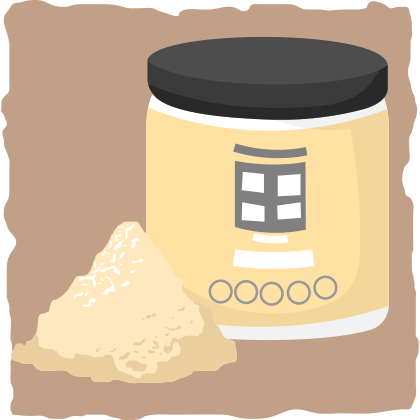
Most people are deficient in magnesium, so a magnesium-containing ketone salt may be best for you.
The ketone body you should get is, without a doubt, BHB. On a biochemical level, this ketone body goes through an additional chemical reaction that helps increase cellular energy, which means you’ll get more energy out of BHB than any other ketone body.
2. MCT Oil
Although they aren’t ketones themselves, medium chain triglycerides (MCTs) can be broken down into ketone bodies in the liver whether the body is in ketosis or not.
MCTs are a saturated fat that is unlike any other saturated fat. They skip the typically slow and arduous process of fat digestion and go straight to the liver where they can be converted into ketone bodies right away. This happens regardless if you are on a high-carbohydrate diet or a ketogenic diet — amazing!
These ketone boosting fats are naturally found in coconuts, coconut milk, and coconut oil, but the most efficient way to consume MCTs is by taking an MCT oil supplement.
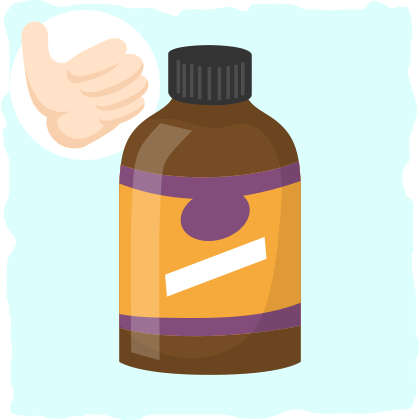
The best MCT oil to take is one that exclusively contains a medium chain triglyceride that is called caprylic acid (the C-8 medium chain triglyceride). Caprylic acid is known to digest more quickly and easily into ketones than the other types of medium chain triglycerides.
However, if you can’t afford the higher price tag of caprylic acid, any other MCT oil will do. Put a tablespoon or two of KetoMCT oil or Now Sports MCT oil in protein shakes, salad dressings, or sauces for a consistent ketone boost with no side effects.
Whether you stick to the ketogenic diet or try one or both of these ketone boosting supplements, you still need to know the answer to one critical question — how do you know if you are actually in ketosis?
How To Know if You Are in Ketosis
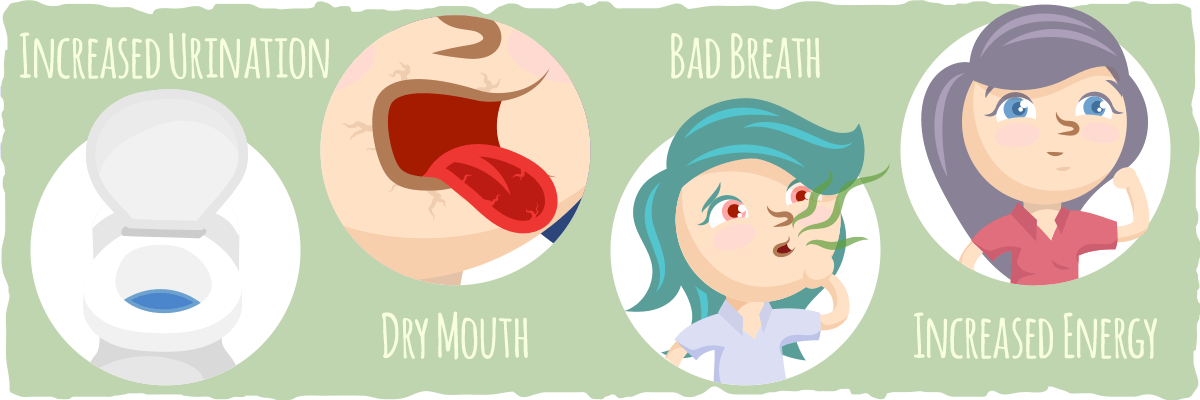
The only way to know with complete certainty that you are in ketosis is by measuring your blood ketone levels. The most accurate way of measuring your blood ketone levels is with a blood meter like the Precision Xtra. With a price tag of $28-$30, the Precision Xtra seems cheap at first, but it’s not the only thing you need to test your ketone levels.
For each test, you’ll also need a ketone test strip, which will cost you $4. This means that if you are looking to test yourself every day, it is going to cost you $120 a month plus the $28-$30 blood ketone meter.
Before you jump online to order your test kit, it is important to know that checking your ketone levels is not essential. There are other ways to know if you are in ketosis.
However, if the price tag and the finger pricks don’t steer you away, here is a link to the starter kit you can get on Amazon and a guide to what the ranges mean:
- Light Ketosis: 0.5 mmol/L – 0.8 mmol/L
- Medium Ketosis: 0.9 mmol/L – 1.4 mmol/L
- Deep Ketosis (best for weight loss): 1.5 mmol/L – 3.0 mmol/L
Most people will be in a light ketosis within two or three days from ketogenic diet alone. It typically takes two to three weeks to get into a deep ketosis. However, if you implement some of the suggestions in this article, you may be able to get into a medium or deep ketosis after a couple of days. For a closer look at how to measure ketosis, check out our in-depth article on the subject.
Not willing to spend the extra cash and prick your finger every day? Me neither.
Instead, you can simply use this short list of physical “symptoms” that usually let you know if you’re on the right track:
- Increased Urination. Keto is a natural diuretic, so you have to go to the bathroom more. Acetoacetate, a ketone body, is also excreted in urination and can lead to increased bathroom visits for beginners.
- Dry Mouth. The increased urination leads to dry mouth and increased thirst. Make sure that you’re drinking plenty of water and replenishing your electrolytes (salt, potassium, magnesium).
- Bad Breath. Acetone is a ketone body that partially excretes in our breath. It can smell sharp like overripe fruit, similar to nail polish remover. It’s usually temporary and goes away long term.
- Reduced Hunger & Increased Energy. Usually, after you get past the “keto flu,” you’ll experience a much lower hunger level and a “clear” or energized mental state.
There’s no need to drive yourself crazy with ketone measurements. As long as you eat the right foods in the right macronutrient ratios, you will be able to experience the benefits of ketosis.
Putting It All Together — Carbs for Ketosis (and everything else)
How many carbs on keto? Short answer: keep your total carbs below 35 grams.
But even if you eat no carbohydrates at all, you may not get into a deep ketosis if you’re not eating the right amount of protein. The keto calculator is the simplest tool that you can use to help you figure out how much to eat of the three macronutrients for optimal results.
Once you are eating the right amount of carbs, protein, and fat, it may take up to 3 weeks for you to get into a deep ketosis. To speed up the process, you can use high-intensity exercise and intermittent fasting to deplete glycogen and low-intensity exercise and a 1-2 day fast to increase ketone levels more quickly. Try supplementing with ketone salts or MCT oil for an extra ketone boost.
These recommendations along with the recommendations in our beginner’s guide will work for almost everyone that is starting the ketogenic diet. Athletes and workout beginners, however, may benefit from increasing their carb intake at the right times. To find out how to do this properly, check out the targeted ketogenic diet and the cyclical ketogenic diet.
Sources:
- Intermittent Fasting on a Keto Diet — ruled.me
- What Are Ketones? Everything You Need to Know — ruled.me
- What is Gluconeogenesis? — ruled.me
- What is the Keto Flu & How to Remedy It? — ruled.me
- High Intensity Exercise and Glycogen Depletion — Single Cell Biology
- Medical aspects of ketone body metabolism. — NCBI